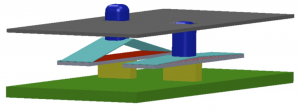MEMS-enabled Tactile Displays for the Blind and Visually Impaired
- Category: MEMS & BioMEMS
- Tags: luis velasquez-garcia
According to the World Health Organization, more than 285 million people have visual impairments worldwide, and 39 million of those are blind. About 20% of visual impairments cannot be prevented or cured; in these cases, assistive technologies are critical to enable independent integration into professional and social settings. There is a pressing need for technologies that enable the blind and visually impaired to acquire graphical information or navigate in unstructured environments. The purpose of this project is to enable compact, rapidly refreshable tactile displays that provide information in an intuitive format as part of a broader system for situational awareness, navigation, and perception of graphical information. The overall system is a collaborative effort among MIT’s Computer Science and Artificial Intelligence and Microsystems Technology Laboratories, and researchers from Northeastern University; the tactile display is the focus of this abstract.
We are developing the scientific and engineering knowledge for high-resolution displays of rapidly-updatable, vibrating tactile elements, i.e., tactels (Figure 1), using a combination of macro- and microscale batch manufacturing techniques. The proposed architecture is entirely distinct from the conventional piezoelectric bending beams of refreshable Braille readers or the Optacon[1], as well as from the actuators of electroactive polymer displays[2]. Our tactels use structures that receive in-plane displacement from piezo beams to produce amplified out-of-plane displacements that can be sensed by human hands. Current work focuses on parametric multiphysics modeling of the tactels and development of the manufacturing process and assembly approach for the MEMS displays.

Figure 1: Schematic of two MEMS tactels (one fully actuated and another fully relaxed), showing the piezo actuators (red), displacement amplifiers (light blue), pins (deep blue), and cap plate (gray).
- L. H. Goldish and H. E. Taylor, “The Optacon: a valuable device for blind persons,” New Outlook for the Blind, American Foundation for the Blind, pp. 49-56, Feb. 1974. [↩]
- Y. Kato, T. Sekitani, M. Takamiya, M. Doi, K. Asaka, T. Sakurai, and T. Someya, Sheet-type Braille displays by integrating organic field-effect transistors and polymeric actuators, IEEE Trans. Electron Dev., vol 54 , no. 2, pp. 202–209, 2007. [↩]